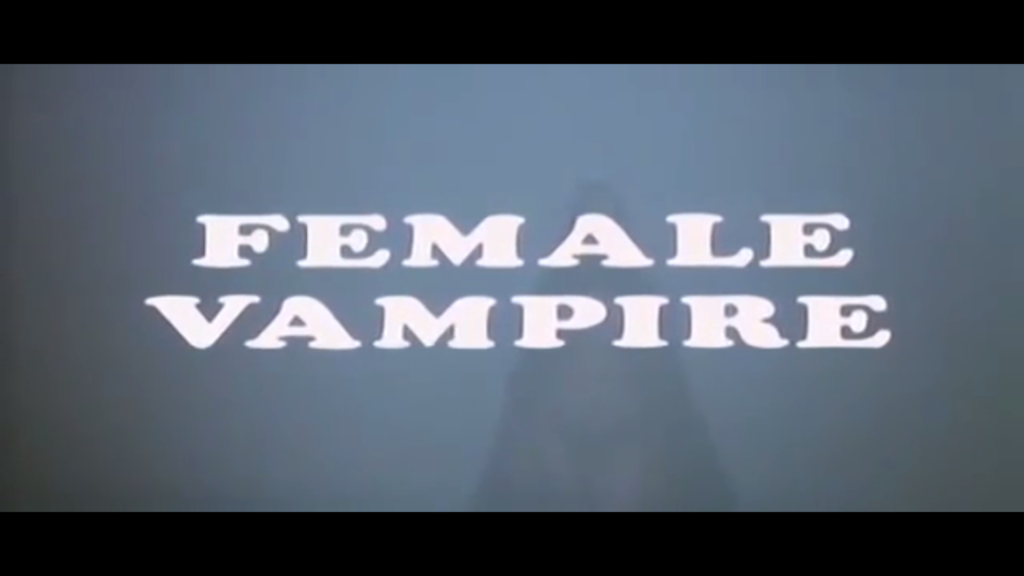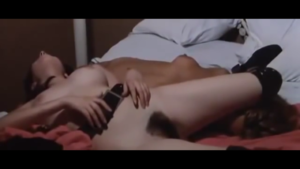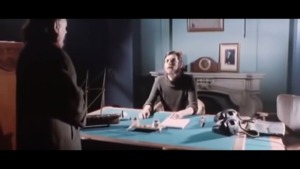Female Vampire (1975)
Netflix Review excerpt:
“Let’s put it this way: Lina Romay has sex with a bed. Not in a Linda Blair meets the cross kind of way. This woman seduces and ravishes a bed. It … is …incredible.” – 3 out of 5 stars. 28 out of 28 found this review helpful.
Netflix Full Review:
“My first review. GREAT body. Nice close up shots. Firm, perky b r e a s t. Watch it. 1 January 2014” 3 out of 5 stars. 3 out of 4 found this review helpful.
You can read my longer thoughts on this film below, but these two Netflix users pretty much said what matters. (Unfortunately, the movie is no longer on Netflix in the US.)]
Jess Franco’s Female Vampire is, if not one of the great movies, at least one of the great cinematic experiences of all time. We turned to this movie directly after Nightmares Come at Night piqued our interest in Franco, and immediately we recognized the same hand at work: the same motifs (not to say tics), the same incessant zooming, the same disregard for common good taste.
We begin in a misty wood, and towards the camera comes a woman who will change your life: Lina Romay. She is wearing the following articles of clothing: a thin, black cape, hanging down her back; a wide black belt around her hips; and black boots. The costume designer, like a good prose editor, recognized that everything in between was filler, and cut it. Like a Grecian statue, she needs nothing but her defining attributes. As she approaches the camera, Jess pans down her body directly to the dark triangle of her Godhead, then back up. After he’s done panning and zooming all over her, she keeps walking toward the camera until she literally bumps into the lens. No one cuts it out. eep! 🙂
Whatever a “good movie” is supposed to be, we are not in a world where that matters.
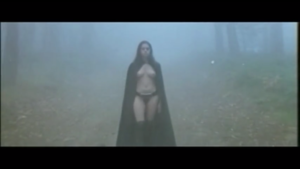
There is no world where being Lina Romay does not matter. Our world is better for having contained her; the world of Female Vampire revolves around her. She was born (in our world) as Rosa Maria Almirall, and took the name of a jazz singer after meeting Jess (who also took many of his pseudonyms from jazz musicians.) At the time of filming this movie, she was only nineteen, and had never taken (taken) the lead in a film before, though she played smaller parts in previous Franco movies like Tendre et perverse Emmanuelle (1973). In this debut, she proves her willingness to do absolutely anything on camera; later in their careers her generosity may have let Jess get away with too much.
After her long march towards the camera, Lina goes on to wordlessly seduce, fellate, and kill a local chicken farmer, before flying away as a bat (not pictured). The next morning, we see her getting dressed—in a special, nobler sense of the word that means “robed in sheer white cloth.” At the same time, our other would-be protagonist, a poet (Jack Taylor) who has come to Madeira (this movie is set on Madeira by the way) in search of some kind of transcendence, is grooming his magnificent ’70s mustache. (What a Mustache! might actually be his character’s name.)
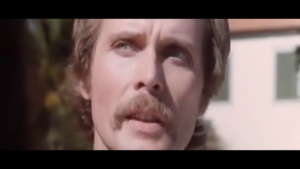
Just … just look at it.
A bikini-clad reporter approaches Lina by the hotel pool and they have an interview back up in Lina’s rooms. We learn that she (Lina) is the Countess Irina Karnstein (a descendant, presumably, of the vampire family from Carmilla) and a mute. She answers by gracious, imperious nods and slow shakes of the head as the reportress asks typical reporterly questions like:“Do you think this affliction is a consequence of the curse that has weighed on your family for centuries?” and “Do you feel ill at ease being the descendant of a family of vampires?” When asked how she feels about her ancestors’ bloody deeds, she gives the coyest, subtlest smile you’ve ever seen.
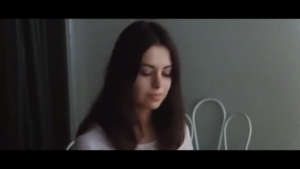
Here is a blurry version of it.
Uncle Jess himself appears as Dr. Roberts, presumably the coroner, meeting with the inspector to discuss the dead chicken man from earlier. In this scene, he utters the following line: “he was bitten… in the middle of an orgasm. The vampire sucked his semen and his life away.” There’s something incredible about this moment. This line sounds like it belongs in a porn parody of a vampire movie, not a serious vampire film. But Jess knows better. He knows sexual subtext is a waste of good text. Leaving sexual content all coy and unspoken (and unshown) makes sex too important. If you hide sex behind your story, your story ends up being only about sex; and if you’re making a story about sex, you might as well admit it and not waste everyone’s time. Sex here isn’t the god in the hidden sanctuary, it’s the public worship going on out front, as awkward as prayer. (THIS)
People reviewing Franco movies talk about his bad simulated sex scenes, but that phrase seems to miss the point. It implies that Jess cares about simulating sex, which he clearly doesn’t; dicks that flop into view are clearly flaccid, genital areas don’t even remotely line up, actresses moan with pleasure while no one is touching any of their erogenous zones whatsoever. In terms of making it look like there’s really a penis going into a vagina somewhere, we’re way outside the realm of failure and into the realm of not trying to do that. It’s not poorly faked , it’s … emblematic: you’re seeing something that clearly represents two people having sexual intercourse, but just as clearly isn’t (cough*). When I think of badly simulated sex, I think of the typical Hollywood or TV sex scene, where the whole bottom half of the body is carefully kept out of frame, and sights of even nipples (if allowed) are calculated and dripped out with an eyedropper. Is the premeditated Hollywood sex more artful? Not if exuberance is beauty. (I for one choose exuberant death!)
(*I say it IS poorly faked though, and it’s one of the examples where the natural filmmaking awkwardness -of having a sex scene without showing sex- in the Jess version of filmmaking purely accidentally transcends itself becoming graphic, silly and gratuitous… but as opposed to what? Then you start wondering what you’re used to seeing in ‘this kind of scene’ and it becomes -again, purely accidentally- artistic criticism on censorship and the Hollywood norms you’ve shoved in your face since birth, which are even more silly and downright patronizing when simulating intimacy and/or coitus. Uncle Jess would never lie to us.)
The movie goes skin-deeper when Dr. Roberts goes to meet a colleague, Dr. Orloff, meant to be the son of the Dr. Orloff from one of Jess’s first directorial efforts, Gritos en la Noche / The Awful Dr. Orloff (1962). The younger Orloff is blind, and a delver into forbidden things: “Oh, I search, and sometimes in the darkness I find the answers that in the light one cannot find.” Roberts asks him about the Countess, whom Orloff has sensed is on the island. “Is she alive?” asks Dr. Roberts, and Dr. Orloff replies to him and to us, “Are you alive?” These two doctors are possibly my favorite part of this movie, and almost any movie.
They get better in one of their later scenes, when Orloff tells Roberts more about the occult and the vampiric Countess, and Roberts is compelled to say, “But what you say is more than terrifying. The demons must be killed, and it must be forever.” Dr. Orloff replies, spectacularly: “What for? How are we to know that the pleasure isn’t worth life itself? Why fight against it?”
It is at this point in the viewing that I exclaimed “This man knows! He gets it! He knows!” I meant both Dr. Orloff and Jess, who seems to understand the forces that drag other vampire writers around, uncomprehending as marionettes.
Jack Taylor’s poet knows too. He falls in love with the vampiress not despite, but because of what she is. When he asks her, “Will you take me with you someday, behind the mist?” he wants a relationship with the Countess that is denied him; he can never be her equal partner or live in her world. But he understands that she is worthy of his worship, worth becoming food for.
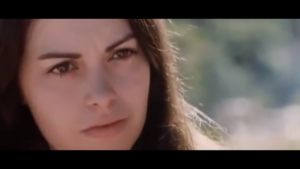
Look. (Sure, I’ll call that a transition.) What is a vampire, and what is its fascination? It is the sexiness of the abstracted idea of evil purged of the dullness of actual, real-life evil. Evil is boring, uncreative, ugly, normal; the imagination, attempting to comprehend its terrors, creates an image that is everything evil isn’t: beautiful, austere, brimming with vital fire. An image for sin’s seductiveness becomes simply a seductive image; a vampire ceases to stand for anything except a vampire. The doctor who thinks he can see is a literalist, and wants to hunt down the beautiful monster because surely it stands for something; the blind doctor Orloff knows better, and is right to answer, “What for?”

